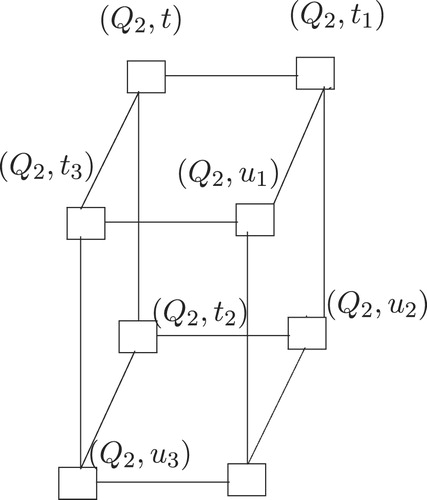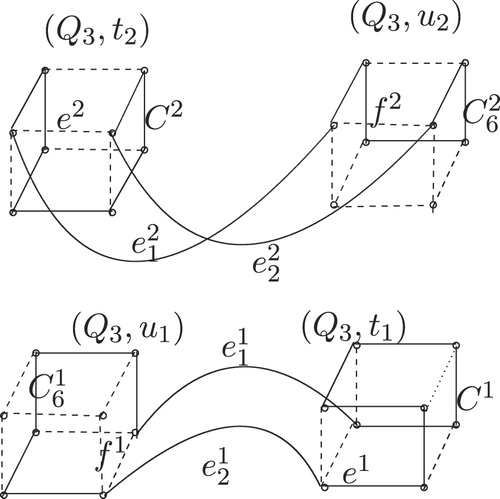 ?Mathematical formulae have been encoded as MathML and are displayed in this HTML version using MathJax in order to improve their display. Uncheck the box to turn MathJax off. This feature requires Javascript. Click on a formula to zoom.
?Mathematical formulae have been encoded as MathML and are displayed in this HTML version using MathJax in order to improve their display. Uncheck the box to turn MathJax off. This feature requires Javascript. Click on a formula to zoom.Abstract
The connectivity of a graph is an important measurement for the fault-tolerance of the network. To provide more accurate measures for the fault-tolerance of networks than the connectivity, some generalizations of connectivity have been introduced. Let be a connected subgraph of a graph
. A set
of a connected subgraphs of
is called a subgraph cut of
if
is either disconnected or trivial. If further, each member of
is isomorphic to
, then
is called an
-structure cut of G. The
-structure connectivity
of
is the minimum cardinality of an
-structure cut of
. In this paper we determine
or its upper bound where
is the
-dimensional hypercube with
and
is either
with
or even cycle
with
.
Keywords:
1 Introduction
In the design of an interconnection system, one important consideration is that the network should be least vulnerable to any disruption. The ability of a system to continue operations correctly in the presence of failures in one or many of its components is known as fault tolerance. The connectivity is one of the essential parameters to evaluate the fault tolerance of a network. To make an overall evaluation of an interconnection network with failures, some other measures related to connectivity have been introduced and studied in recent years [1–3Citation[1]Citation[2]Citation[3]].
Lin et al. [Citation4] introduced a new kind of connectivity called structure connectivity. According to them, a set of connected subgraphs of
is a subgraph cut of
if
is disconnected or trivial graph. Let
be a connected subgraph of
. Then
is an
-structure-cut if
is subgraph cut, and every element in
is isomorphic to
. They defined the
-structure connectivity of
denoted by
, to be the minimum cardinality of all
-structure-cuts of
. This study was motivated by the trend that networks and subnetworks of large scales are increasingly made into chips, and it is becoming more and more feasible to consider the fault status of a structure, rather than individual nodes. They obtained
for each
.
In this paper, we determine or its upper bound where
is the
-dimensional hypercube with
and
is
where
and an even cycle
with
.
For a positive integer , we denote the hypercube graph
whose vertex set i.e.
consisting of binary strings of length
. Two strings are adjacent if they differ in exactly one-bit position.
has many attractive properties, such as being bipartite,
-regular,
-connected, edge-bipancyclic. Due to these and many more attractive topological properties, hypercube has been one of the most fundamental interconnection networks.
We decompose . Now, for any
we denote by
the subgraph of
induced by the vertices whose last
components form the tuple
. It is easy to observe that
is isomorphic to
.
For undefined terminology and notations see [Citation4,Citation5].
2 Structure connectivity of hypercubes
Theorem 2.1
Let be an integer. Then for each
,
and
.
Proof
Let . As
is
-regular and
-connected, every vertex in
is adjacent to exactly
number of vertices. Let
be adjacent to
. Hence induced subgraph
of
is adjacent to exactly
subcubes namely
(see for an illustration). Clearly, removal of
disconnects
. Thus,
. If
, then without loss of generality one can assume that removal of
disconnects
. Hence the removal of
will disconnect
a contradiction to
is
-connected. Hence
Since is Hamiltonian, it contains a spanning cycle of length
. Removal of isomorphic Hamiltonian cycles of all subcubes
disconnect
. Hence
. □
Proposition 2.2
Let be an integer. Then for any integer
with
and for any even integer
with
.
Proof
Let (
). Let
be adjacent to
number of vertices say
. It is well known that hypercube is a bipartite graph so,
is not adjacent to
for all
(
). Also, every pair of adjacent edges lies in exactly one
-cycle [Citation6]. Hence we name vertices say
from
such that
is adjacent to say
for all
(see for an illustration).
In the case when , we take vertices of
as
. Hence the
cycle in
we take as
. See .
The construction of cycles of length for every even integer
(
) proceeds as follows. We start by choosing an arbitrary Hamiltonian cycle say
of
for every
(
). Then we choose any edge say
on
and its corresponding edge
in
. As
is an edge-bipancyclic graph there exist cycles
of length
for every even integer
(
) containing
. Therefore by gluing cycles
and
in the following manner
, we obtain a cycle
of length
(
), for
glue cycle
with an edge
. (See for illustration of
. In this figure two cycles of length
are shown by solid lines. It can be checked that by removal of these cycles,
gets disconnected.)
It is easy to observe that removal of cycles for all
,
disconnect
. □
Note: In case of , it can be easily observed that
.
Proposition 2.3
Let be an integer. Then for every even integer
with
,
.
Proof
Let . Let
and let
be the
cycle in
. Denote by
the set of cross edges between
and
for
and
.
We start by choosing an arbitrary Hamiltonian cycle say of
and choose any edge say
on
. Consider an edge
which is corresponding to the edge
. As
is an edge-bipancyclic graph, there exist cycles
of length
for every even integer
(
) containing an edge
. Let
is an edge on
which is nonadjacent to
. Denote by
the corresponding edge of
and let
be a Hamiltonian cycle of
containing
. Let an edge
be some another nonadjacent edge on
. Now denote by
the corresponding edge of
and cycles of length
for every even integer
(
) by
which contain an edge
. Note that
and
.
The construction of cycles of even length , with
, proceeds as follows.
: By gluing cycles
and
in the following manner
for every even integer
with
. (See for an illustration. In we have shown the effect of removal of a cycle of length
from
.)
:
for every even integer
with
.
: for
, we construct
.
Lastly,
: For
, we proceed in the following manner
. Here, we consider
,
and
are all corresponding Hamiltonian cycles (isomorphic to each other) and
and
have one common vertex on
as well
and
have one common vertex on
. □
3 Concluding remarks
In this paper, we obtained or its upper bound where
(
) denotes hypercube,
is either a hypercube
for
or a cycle
of length
where
is even and
.
But the question still remains open . For
and for each
, can we prove
?
Also, we can ask the same type of questions in the case of numerous variations of the hypercube.
Notes
Peer review under responsibility of Kalasalingam University.
References
- Esfahanian A.H. Hakimi S.L. On computing a conditional edge-connectivity of a graph Inform. Process. Lett. 27 1988 195 199
- Fábrega M.A. Fíol On the extraconnectivity of graphs Discrete Math. 155 1996 49 57
- Harary F. Conditional connectivity Networks 13 3 1983 347 357
- Lin Cheng-Kuan Zhang Lili Fan Jianxi Wang Dajin Structure connectivity and substructure connectivity of hypercubes Theoret. Comput. Sci. 634 2016 97 107
- West Douglas B. Introduction to Graph theory Second Edition 2002 Prentice-Hall of India New Delhi
- Laborde J.-M. Rao Hebbare S.P. Another characterization of hypercubes Discrete Math. 39 1982 161 166



